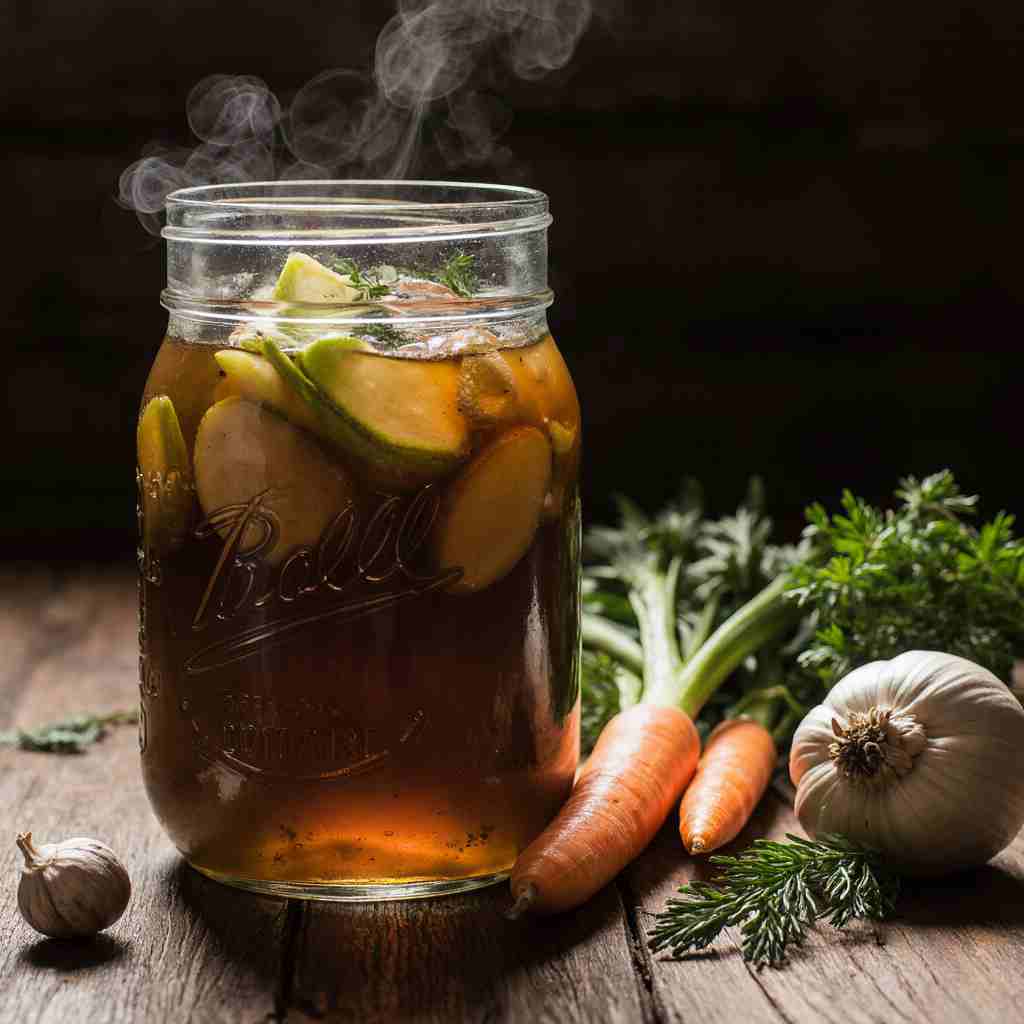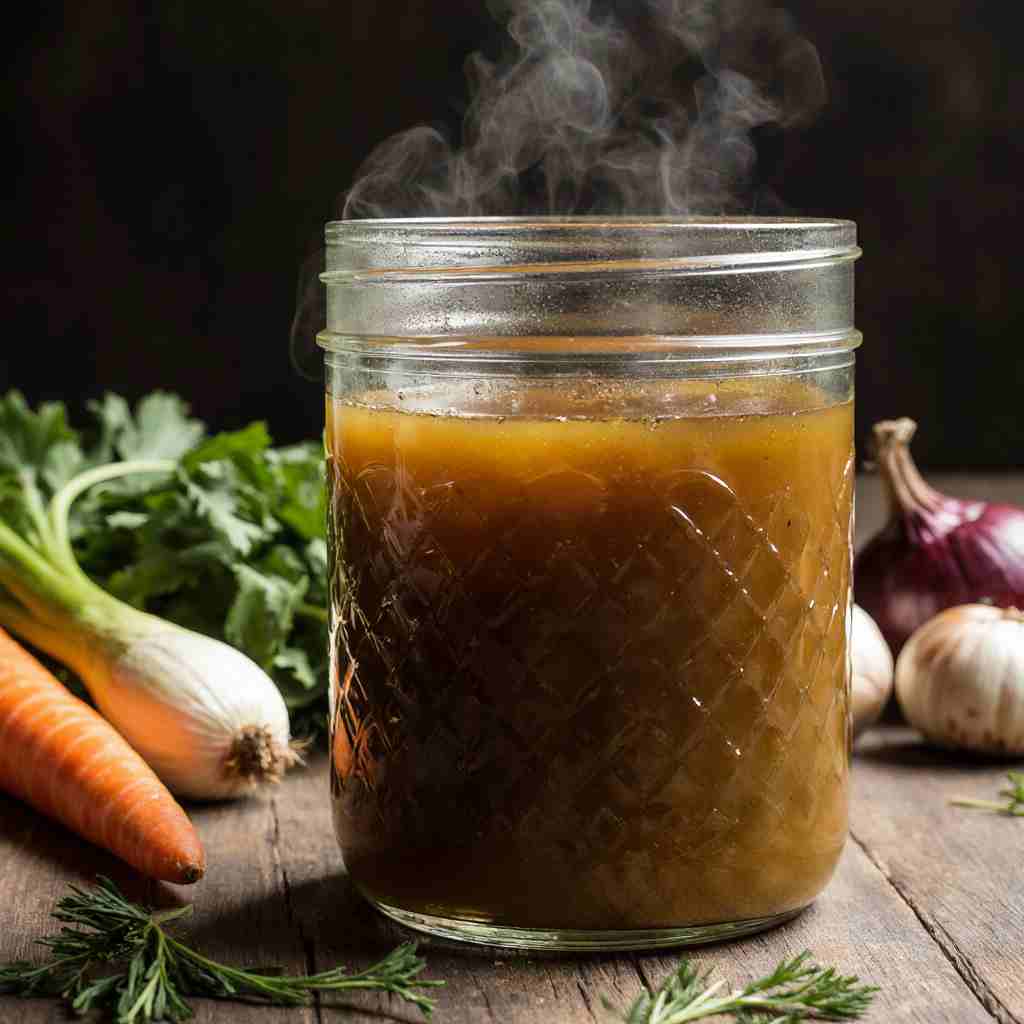Canning Vegetable Stock is the perfect way to transform leftover vegetable scraps into a rich, healthy, and shelf-stable broth. This easy recipe helps you reduce kitchen waste while creating a versatile base for soups, stews, sauces, and risotto. With simple ingredients and safe canning techniques, you can enjoy homemade vegetable broth all year long — free from preservatives and packed with natural flavor. Whether you’re an experienced home canner or just starting out, this guide will show you how to preserve your garden’s goodness in every jar of delicious vegetable stock.
Table of Contents
What is Canning Vegetable Stock?
Canning Vegetable Stock is the process of preserving homemade vegetable broth by sealing it in jars and subjecting it to heat in a water bath canner or pressure canner. The heat destroys microorganisms and creates a vacuum seal, preventing spoilage and allowing the stock to be safely stored at room temperature for extended periods.
This method transforms garden surpluses, leftover vegetable trimmings, and even “ugly” produce into a versatile and flavorful kitchen staple. By canning your own vegetable stock, you control the ingredients, avoid artificial additives and preservatives found in store-bought versions, and significantly reduce food waste. It’s a rewarding and practical way to enhance your cooking and become more self-sufficient in the kitchen. Ready to start saving scraps and creating amazing broth? Give this recipe a try – you’ll be amazed at how easy and satisfying it is!
Key Ingredients for Canning Vegetable Stock:
- 8 cups Vegetable Scraps: A mix of onion peels, carrot peels, celery ends, garlic cloves, mushroom stems, bell pepper cores (remove seeds), tomato cores or ends and herbs like parsley stems and thyme twigs. Ensure that all scraps are clean and free from mold or decay. Avoid strong-flavored vegetables like broccoli, cabbage, turnips, and cauliflower, as they can overpower the broth.
- 1-2 Bay Leaves: These add a subtle, savory depth to the broth.
- 1 teaspoon Whole Black Peppercorns: These provide a gentle peppery note.
- 1 teaspoon Dried Herbs (Optional): Such as Italian seasoning or herbes de Provence, add extra complexity to the flavor.
- 1 tablespoon Apple Cider Vinegar or Lemon Juice (Optional):This is added for safe canning practices, however, it also helps release the natural pectins in the ingredient, creating a slightly thicker broth.
- Water to Cover: Use filtered water for best results. The amount of water needed will depend on the size of your pot and the volume of vegetable scraps.
How to Make Canning Vegetable Stock:
This recipe is surprisingly simple and transforms your kitchen scraps into liquid gold! It’s a fantastic way to reduce waste and create a genuinely delicious and healthy broth. The preparation is minimal; the stock simmers on the stove for a few hours, and finally, all that it needs is canning, for about an hour. The result is a flavorful, ready-to-use broth that will elevate your soups, stews, and sauces. Get ready to enjoy the taste of homemade goodness – this recipe is a winner!
- Preparation time: is approximately 15 minutes.
- Cook time: ranges from 2-3 hours for simmering the stock.
- Canning time: is 60 minutes for quarts.
Why You’ll Love This Canning Vegetable Stock:
Canning your own vegetable stock is a game-changer in the kitchen. The biggest highlight is the incredible flavor it adds to your cooking – far surpassing anything you can buy in a store. Plus, it’s a fantastic way to save money by using vegetable scraps that you would otherwise throw away. The versatility of this stock is unmatched; it serves as the perfect base for soups, stews, sauces, and risotto, adding depth and richness to every dish. Compared to store-bought broths loaded with sodium and preservatives, homemade stock is healthier and more flavorful.
If you also enjoy the process of making bone broth, you might also like fermenting vegetables to preserve them. Consider this Canning Vegetable Stock as the vegetarian’s answer to homemade broth that boosts nutrients and flavor. Why not start collecting those vegetable scraps today and dive into the world of homemade, canned goodness?
What to Serve Canning Vegetable Stock With:
Canning Vegetable Stock is incredibly versatile and can be used as a base for a wide variety of dishes. Here are a few suggestions:
- Soups: Use it as the base for classic vegetable soup, minestrone, or creamy tomato soup.
- Stews: It’s perfect for adding depth of flavor to hearty stews like lentil stew or vegetarian chili.
- Sauces: Incorporate it into sauces for pasta dishes, such as marinara or Alfredo, to enhance their richness.
- Risotto: Use it in place of water when making risotto for a creamy and flavorful dish.
- Grain Dishes: Cook grains like quinoa, rice, or couscous in vegetable stock for added flavor.
Top Tips for Perfecting Canning Vegetable Stock:
- Avoid Cruciferous Vegetables: Vegetables like broccoli, cauliflower, and cabbage can make the stock bitter. Limit their use or avoid them altogether.
- Don’t Overdo Strong Flavors: Avoid using too many peels from stronger-flavored vegetables like bell pepper and fennel, as they can easily overpower the other ingredients.
- Roast Your Vegetables: Roasting your vegetables before simmering the stock can add a depth of flavor. Roasting them imparts a slight sweetness and caramelization.
- Don’t Salt the Stock: It’s best to avoid adding salt to the stock during the cooking process. This allows you to control the sodium content when you use the stock in recipes.
- Use a Fine-Mesh Sieve: For a clear and smooth stock, strain it through a fine-mesh sieve or cheesecloth.
- Headspace is Key: Ensure accurate Headspace of approximately 1-inch is extremely important because it can affect the safety of the recipe.
- Listen for the Pop: Ensure during the cooling process you listen for the pop.
Health Benefits of Canning Vegetable Stock

Canning Vegetable Stock offers numerous health benefits. It’s a low-calorie, nutrient-rich liquid that provides essential vitamins and minerals from the vegetables used. It’s an excellent source of hydration and can help support the immune system with its vitamin and antioxidant content. Homemade stock is free from the artificial additives, preservatives, and high sodium levels often found in commercial broths. Using organic vegetables ensures a pesticide-free stock, further enhancing its health benefits. Regular consumption of vegetable stock can contribute to overall well-being and support a healthy lifestyle.
Final Thoughts:
Canning Vegetable Stock is an empowering and fulfilling kitchen skill that not only reduces waste but also enhances the flavor and healthfulness of your meals. With this guide, you can confidently create your own supply of delicious, homemade broth that’s ready to use in any recipe. So, gather your vegetable scraps, follow these steps, and savor the satisfaction of a well-stocked pantry and a flavorful kitchen.
Read more :
Canning Vegetable Stock: FAQs
Q: What vegetables should I avoid using in my vegetable stock?
A: Avoid overusing strong flavors such as cruciferous vegetables like broccoli, cauliflower, and cabbage, as they can make the broth bitter. Also be careful with bell pepper, as the flavor can easily overpowering.
Q: Do I need to add salt to my vegetable stock?
A: It’s best to avoid adding salt during the cooking process, as this allows you to control the sodium content when you use the stock in recipes.
Q: Can I use frozen vegetable scraps for making stock?
A: Yes, you can use frozen vegetable scraps. Just make sure to rinse them before using.
Q: How long does canned vegetable stock last?
A: Properly canned vegetable stock can be stored in a cool, dark, and dry place for up to one year.
Q: How do I know if my canned vegetable stock has gone bad?
A: Check for signs of spoilage, such as bulging lids, unusual odors, or cloudy liquid. If you notice any of these signs, discard the stock.
Q: Can I make vegetable stock in a slow cooker?
A: Yes, you can make vegetable stock in a slow cooker. Simply combine the ingredients in the slow cooker, cover with water, and cook on low for 6-8 hours. Strain before canning or storing.
Q: Is it safe to can vegetable stock on the stovetop?
A: No, vegetable stock must be canned in either a pressure canner to ensure safe preservation. Because vegetable stock is a low-acid food, it requires pressure canning to ensure proper safety, by destroying the microorganisms that leads to botulism.

